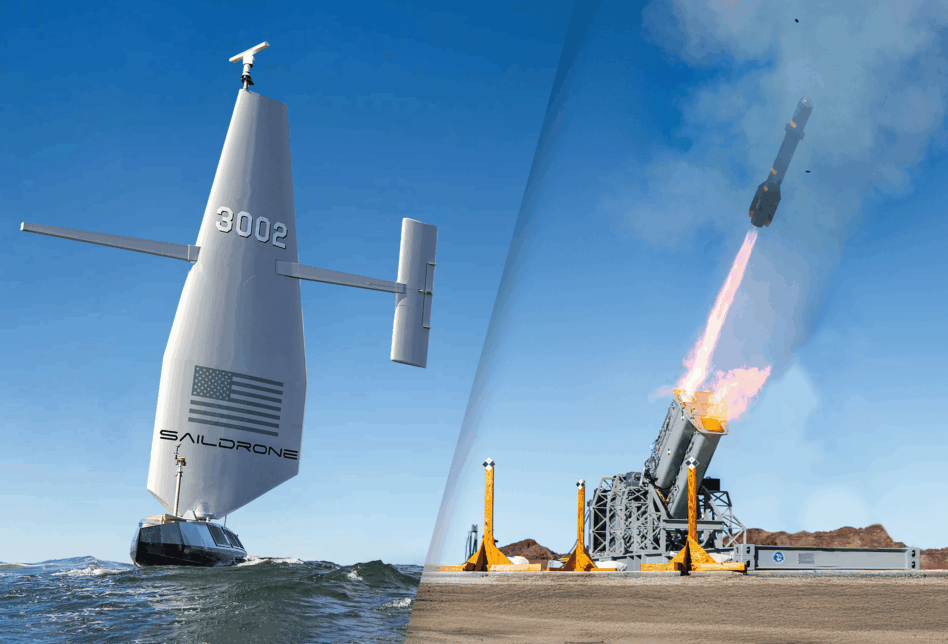Well, looks like the sailboat drones are getting a major, deadly upgrade. Yesterday, USV company Saildrone announced that it’s secured a $50M investment from Lockheed Martin and that it will build a whole bunch of the prime’s weapons onto its boats.
Saildrone CEO Rich Jenkins also told Tectonic that the two companies will work together to build bigger, motor-powered (sail-assisted) boats that can carry bigger and badder payloads (read: the stuff that goes boom, big time.)
“This is really a partnership to equip our vehicles with Lockheed payloads—a whole range of payloads, from EW through to kinetics,” he said. “It’s a major transition for us.”
Out at sea: Saildrone certainly did not start out making deadly weapons—the company was founded by Jenkins all the way back in 2012 and set out to make wind-powered unmanned vessels that could collect oceanographic, meteorological, fishery, and climate data over long durations. In 2020, Jenkins said, they started working with the US Navy, and now about 98 percent of their revenue comes from defense.
A major transition, indeed.
“Back [then], the world wasn’t ready for militarized unmanned systems,” Jenkins said. “I think the world has fundamentally changed with the Ukraine conflict, understanding the value of small systems.”
Pick your flavor: To date, Saildrone has built mostly wind- and solar-powered vessels (with motor assist for stickier situations). The drones:
- Come in three sizes: the 23-foot Explorer, 33-foot Voyager, and 65-foot Surveyor.
- Can operate in GPS-denied environments.
- Are kitted out with high-powered radar and cameras that can cover thousands of square miles every day at a “fraction of the cost” of crewed boats.
- Can stay at sea for up to a year (for Explorer, according to Saildrone). Surveyor has operated continuously for up to 26 days on Navy exercises.
And despite the no pew-pew, they’ve gotten a lot of work with the DoD and Navies around the world.
- 20 of its Voyager vessels are Operation Southern Spear, an anti-narcotics operation in the Gulf of Mexico led by JIATF-S and NAVSOUTH.
- Voyagers are also deployed as part of the US Navy’s Task Force 59 (T59) in the Middle East, and were part of NATO’s Task Force X exercise in the Baltic Sea in June.
Go boom: So, what will this Lockheed partnership mean for the vessels Saildrone builds? Jenkins said the ships would get bigger, badder, and more motor-powered—plus those nasty payloads.
“We are building bigger boats. Bigger boats [that] will be fast,” he said. “They’ll be like warships, but they will have the ability to have infinite range and duration due to the wind assist piece.”
If, to date, Saildrone’s boats have been wind-powered with motor assist, he said, the new, Lockheed-powered boats will be motor-powered with wind assist.
In terms of weapons integration, the two companies will start out by building JAGMs and JGLs (updated Hellfires) onto Surveyors, then scale up from there.
“Physically mounting the hardware to the vehicle is not the hard part,” Jenkins said, “The hard part is the complex C2 backend controls, fire control, security, encryption, all of which Lockheed does, which no one else can do. They control the entire fire control system for the Navy, or a large part of it, with the Aegis battle control system.”
Basically, building smaller payloads onto existing vessels is a proof-of-concept for bigger weapons, like the MK 70. Once the backend is in place, Jenkins said, they can keep on scaling things up.
The companies plan to do a live fire of a JAGM on a Surveyor in the next six months, and will roll out those bigger vessels (with big boy payloads) in 2026.
Show me the money, honey: And as for that $50M? Jenkins described it as “general acceleration” for Saildrone.
“Obviously, more capabilities need more people. Bigger boats are much larger things to make, equip, [and] deploy,” he said. “So, it’s really just growth—growth in teams, growth in payload, integration teams, manufacturing teams and operational teams.”
Personally, we can’t wait to see an MK 70 fired off a sailboat drone. 2025 is turning out to be wild.

